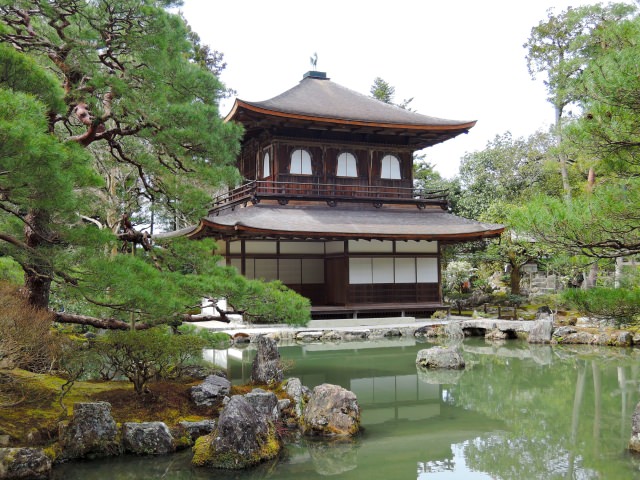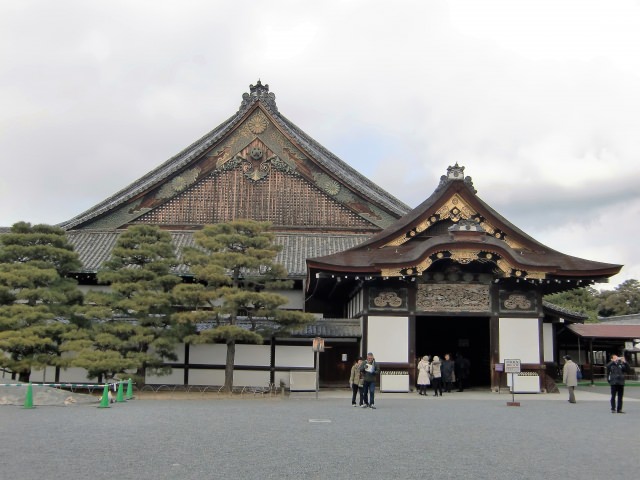10月 21, 2017
Top 10 Tourist Attractions & Best Things to Do in Kyoto, Japan
- 1,140view
Kyoto is often called by its nickname, “One thousand-year-capital”. In 1994, UNESCO appointed the ancient capital Kyoto as an important cultural asset. As many as 17 places of temples, shrines and palaces have been registered as world heritage sites. However, in Kyoto, many other cultural assets have been preserved. There are so many places to go to and so many things to see that you can’t visit all of them in a day. So, we’ll introduce to you our recommended popular sightseeing spots which you shouldn’t miss on your trip!
1. Fushimi-inari Taisha (Shrine)

This famous Fushimi-inari has come top among the popular sightseeing spots for foreign visitors during the past few years. This is the head shrine of all Inari shrines which have folk beliefs. Many people visit there to pray for their prosperous business or for the safety and health of the family every year.
The 1,000 red Torii are in lines going skywards. When you walk along the path enclosed by them, you may feel as if you are in the mysterious world. If you intend to go up to the top, it is challenging, it will take more than 1 hour. Beforehand, put on some comfortable, suitable footwear.
Name: Fushimi-inari Taisha(shrine)
Address: 6-8 Fukakusayabunouchi-cho Fushimi-ku Kyoto-shi Kyoto-fu
Admission fee: free
Access: just a short walk from the Inari station on the JR Nara-line or from the Fushimi-inari station on the Keihan-honsen-line.
Website: http://inari.jp/
2. The Golden Pavilion, Kinkakuji Temple

One could say that “Kinkakuji” is a representative of all the temples in Kyoto. The formal name of Kinkakuji is Rokuonji. The lofty golden temple built in the pond surrounded by vast nature looks like a Land of Bliss. This is the Reliquary Hall where a fragment of a bone of the Buddha was buried. The gold foil was stuck on the walls and the Chinese Phoenix which is the symbol of celebration in China is shining on the top.
The General Yoshimitsu Ashikaga in the Muromachi Shogunate commanded the building of the Reliquary Hall. He intended to mix the Chinese culture and the culture of a court noble as well as the Samurai culture. Each level has a different architecture which is very interesting. The Reliquary Hall itself is, of course beautiful, but its reflection in the pond is also terrific. You may get lost in time when you gaze at the sight.
Name: Kinkakuji(Rokuon-ji)
Address: 1 Kinkakuji-cho Kita-ku Kyoto-shi Kyoto-fu
Opening hours: 9:00 – 17:00
Closed: none
Access: just a short walk from the Kinkakujido bus-stop using a city-bus
Website: http://www.shokoku-ji.jp/
3. Ryoanji Temple

If you want to see a beautiful Japanese-styled garden, this is it. It is a small garden with the white sand and the 15 stones. But it has a mysterious attraction which draws people into the tranquil atmosphere. The stones have been arranged perfectly. You can sit in front of it and spend your time as much as you want.
This garden will allow you to think of various ways of interpretation. If you want to meditate quietly, a visit in the morning with less people is recommended. Why don’t you experience Japanese culture in the Zen state in Kyoto? You may start understanding what Zen priests are all about!
Name: Ryoanji
Address: 13 Goryonoshita-cho Ryoanji Ukyo-ku Kyoto-shi Kyoto-fu
Opening hours: [March – November] 8:00 – 17:00 [December – February] 8:30 – 16:30
Closed: none
Access: a 7-minute-walk from the Ryoanji station on the Keifuku-line
Website: http://www.ryoanji.jp/
4. Sanjusangendo
photo by tacao.yamada21 / embedded from Instagram
These 1,000 golden Buddha statues make visitors overwhelmed. Reflecting the turbulent days at the time when the temple was built, those Buddhist Goddesses of Mercy with 1,000 arms were made to rescue people. The 1,000 statues will overpower your imagination.
Each one of them has a different face and every detail has been very skilfully created. It is said that these are the faces that you want to meet or to look like you. In the centre, the 3-meter-tall Buddha statue has been enshrined. It is the highlight of this site and you will be caught up in its solemn atmosphere. It would be a nice memory to keep if you could find a Buddha statue who could be your look-alike.
Name: Sanjusangendo (Rengeoinhondo)
Address: 657 Sanjusangendo-mawari Higashiyama-ku Kyoto-shi Kyoto-fu
Opening hours: [April – October] 8:00 – 17:00 [November – March] 9:00 – 17:00
Closed: none
Access: a 7-minute-walk from Shichijo station on the Keihan-line
Website: http://www.sanjusangendo.jp
5. Kiyomizudera Temple

This temple is always bustling with visitors. As it has a spacious stage like a huge balcony, it is called the “Kiyomizu Stage”. The temple was built overhanging the steep slope. This was built using the inimitable construction method in which no nails were used.
Nowadays, many worshippers and visitors have a grand view from the stage. But it used to be the one on which the dance was dedicated to the God of the temple. Please imagine the dance performance which used to take place on the stage where you are standing! The magnificent view of the entire Kyoto town is seen from this one and only place.
No matter in which season you visit there, the beautiful scenery is spread out in front of you, reflecting the season. The roads leading to the Kiyomizudera, the Ninen-zaka and the Sannen-zaka are very enjoyable spots for strolling about. You can enjoy searching for your souvenirs and tasting some delicious foods.
Name: Kiyomizudera
Address: 1-294 Kiyomizu Higashiyama-ku Kyoto-shi Kyoto-fu
Opening time: 6:00 ~
Closing time: differs depending on the season
Closed: none
Access: a 1-minute- walk from the Gojozaka bus-stop using a city-bus
Website: http://www.kiyomizudera.or.jp/
You May Also Like:
→The 10 Best Places to Eat in Arashiyama, Kyoto
6. Zenrinji-eikando

The Zenrinji-eikando with its 7 mysteries is the most popular spot to view the changing colours. The beauty of the changing colours in autumn is indescribable, but the fresh green maples are also very beautiful. This Zen temple has various attractions, such as the stone garden, the garden encircling the big pond and also the tower from where you can get a good view.
It is very enjoyable to stroll around in the site, as there are many things to see. You can feel the calm and relaxed atmosphere of Zen. It is highly recommended for people who want to meditate, taking their time. Why don’t you visit there during the beautiful changing colours season? It is really wonderful!
Name: Eikando-zenrinji
Address: 48 Eikando-cho Sakyo-ku Kyoto-shi Kyoto-fu
Opening hours: 9:00 – 17:00
Closed: none
Access: a 3-minute-walk from the Nanzenji Eikando-cho
Website: http://www.eikando.or.jp
7. The Silver Pavilion, Ginkakuji Temple

Ginkanuki is an equally admired temple just like Kinkakuji. You can’t miss it in your Kyoto sightseeing. The official name of this temple is Jishoji. The Reliquary Hall which copies the one of Kinkakuji is called Ginkaku. Compared to Kinkaku, you may think that it is elegant but a little plainer.
In the stone garden at the centre, the mountain and the waves are expressed by the piled sand. It is very modern and avant-garde. You may have a serene mind next to the sand which is carefully arranged every day.
The Togudo on the site is the traditional Japanese residential architecture. It is the origin of the present Japanese-styled rooms. Also, it is the source of the original Japanese culture, leaving the Chinese influence by that time. Please experience Japanese the old “Wabi-Sabi” culture in Ginkakuji. You will be very impressed.
Name: Ginkakuji (Jishoji)
Address: 2 Ginkakuji-cho Sakyo-ku Kyoto-shi Kyoto-fu
Opening hours: [March – November] 8:30 – 17:00 [December – February ] 9:00 – 16:30
Closed: none
Access: a 6-minute-walk from the Ginkakuji-mae bus-stop using a city-bus
Website: http://www.shokoku-ji.jp/
8. Nijojo Castle

Nijojo has been appointed as a world heritage site. It is also a very popular sightseeing spot in Kyoto. Ieyasu Tokugawa, the founder of the Edo Shogunate commanded the building of the castle. After coming to Kyoto, he stayed there many times. Unfortunately, the tower of the castle was burnt down in the fire, but you can see the Ninomaru Palace and the beautiful garden.
In the huge hall of the Ninomaru Palace, the Taiseihokan ( the Edo Shogunate parted with its political power) ceremony took place. It is the place which signifies the beginning of the development of modern Japan after the end of the Samurai-era. The dazzling paintings on paper sliding doors drawn by the Kano school show the authority of the Shoguns. It can’t be missed on your visit to the Nijo castle.
Name: Motorikyu Nijojo
Address: 541 Nijojo-cho Nakagyo-ku Kyoto-shi Kyoto-fu
Opening hours: 8:45 – 16:00
Closed: Tuesdays in Dec., Jan., July, Aug. & the end and the beginning of the year
Access: ① just a short walk from the Nijojo-mae station on the underground Tozai-line
9. Byodoin
photo by nassyon / embedded from Instagram
The “Byodoin Hoodo” has a reputation gained from the overwhelming beauty of its appearance among the many architectures in Kyoto. The Uji city is a 30-minute-ride on a train from Central Kyoto. Since the Heian-era, it has appeared in much classical literature as a noblemen’s villa. The Byodoin Hoodo which is famous for the carving on 10-yen coins expresses the Land of perfect Bliss floating on the pond.
The golden Amida-nyorai (the Buddaha Amitabha) inside can be seen from a distance by the general public. It conveys the message that Amida will rescue all people. The reflection of the vermillion red hall floating in the pond is overwhelmingly beautiful.
Uji-tea shops are lined up on the approach to the Temple. You can enjoy various types of gourmet and of Maccha(powdery green tea). It is a highly recommended sightseeing place. The beauty of Hoodo will never let you down. Surely.
Name: Byodoin
Address: 116 Ujirenge Uji-shi Kyoto-fu
Opening hours: 8:30 – 17:30
Closed : none
Access: a 10-minute-walk from the JR Uji station
Website: http://www.byodoin.or.jp
10. Toji Temple

Toji(temple) near the Kyoto station is famous as a temple which the Shingon sect of Buddhism founder, Kukai had reconstructed. Kukai tried to express the Buddha’s world and thought visually. Usually, the Mandara (Buddhist visual scheme of the enlightened mind) is expressed as a plane figure, but he made it into a three dimensional one.
Anyway it was much easier for people to understand the Mikkyo which was brought from China by him. Apart from this three dimensional Mandara, the tallest 5 storied wooden pagoda and the beautiful garden are in this site.
The market which is held on every 21st which is the Kobotaishi(=Kukai) ‘s anniversary of his death, is bustling with worshippers from the morning. People want to seek out things such as antiques or second-hand Kimonos in the market. You can visit there, fitting your schedule to the 21st.
Name: Toji(Kyogokokuji)
Address: 1 Kujo-cho Minami-ku Kyoto-shi Kyoto-fu
Opening time: 5:00 ~
Closing time: differs depending on the season
Closed: none
Access: a 15-minute-walk from the JR Kyoto station on the JR-line
Website: http://www.toji.or.jp
Let’s Enjoy the Tourist Attractions in Kyoto!
What is your impression about those 10 recommended places? You may not be able to decide where you should visit. But even if you can visit one of those places, you can experience a part of the Kyoto history. If you are interested in the places in Kyoto, many more interesting spots are waiting for you. You can either visit many places on a short hurried trip or visit one temple, taking your time. It’s all up to you. Whichever you choose, nothing will disappoint you. That’s for sure!


















